 |
Classic continental European uncommon plugs and sockets |
 |
Classic continental European uncommon plugs and sockets |
| A diversity of plugs have been made that
differ from the common plugs with two identical round pins, 19 mm
apart. For several reasons there was a demand for uncommon types, such
as: (i) different plugs for various tariffs that were used by quite some electricity companies; (ii) polarized plugs (impossibility to reverse life and neutral pole); (iii) plug that could be used safely for higher currents than the usual 6-10 ampere; (iv) plugs that were on purpose incompatible with the common type, meant for special applications. |
 |
 |
 |
 |
 |
 |
| 1 | Bakelite
Schuko plug, rated at 10A - 250V, with pins that have two grooves. Made
in Leipzig, mid 1930s, by Gustav Schortmann & Sohn, who used the
trademark Felmas. {RH} Besides Schuko plugs with standard 4.8 mm round pins, two variants existed with pins that had one or two grooves. They have been designed by AEG (Allgemeine Elektricitäts-Gesellschaft in Berlin) and were patented in 1929 by DRP 558166A. The three type are related to different electricity tariffs that were charged in Germany by RWE (Rheinisch-Westfälischen- Elektrizitätswerke AG, in Essen). Three categories existed. Lighting tariff (Lichttarif) had to be paid for illumination and relative low wattage equipment in homes. Domestic tariff (type H: Haushalttarif or Küchentarif) for heating, electric stoves, washing machines, irons, vacuum cleaners etc. Most equipment used in workshops and factories was charged according to the commercial tariff (type G: Gewerbetarif). |
| 2 | Steatite
basic part of a 1930s Schuko socket for plugs whose pins have two
grooves (as plug no. 1). Socket
has been made by Casp. Arn. Winkhaus, Elektrotechnische Fabrik in
Carthausen (Westfalen). {RH} Schuko sockets and plugs with full round pins were meant for applications within the lighting tariff category; pins with two grooves corresponded to domestic tariff, and one groove to commercial tariff. Moreover, plugs and sockets also had colour marks: white = lighting (see plug no. 3), red = domestic, and yellow = commercial. Each circuit had his own electricity meter. Note that electricity tariff dependent types of plugs and sockets have been made several companies. |
| 3 | Late
1930s Schuko plug with round pins, made by Siemens-Schuckertwerke in
Berlin. A white mark indicates that the plug is meant for lighting type
appliances. {WN} |
| 4 | Bakelite,
not earthed, polarized plug with flat pins (2.5 mm thick). Pin width is
respectively 6.9 and 4.9 mm. Spacing of pin centers is 19 mm. Brand
name: Leopold Kostal in Lüdenscheid (Westfalen). Dating:
1930s. {RH} Note that also polarized plugs with round pins of different diameter have been made, among others by Stotz-Kontakt. |
| 5 | Bakelite,
not earthed*, polarized plug with 5 mm round pin and 2.2 mm flat pin (5
mm wide). Spacing of pin centers is 19 mm. Pin polarity is not
specified. Rating: 10A - 250V. The 1939-'40 Stotz-Kontakt catalog shows
a plug with similar pins; see no. 14350. * an earthed model must also have existed, because the plug interior shows provisions for an earth pin, resulting in three pins in a triangular orientation (earth pin offset approximately 11 mm). Dating: probably late 1930s. {RH} Manufacturer: Ernst Maté G.m.b.H. in Wien (Vienna), Austria. The company was founded in 1918. It merged in 1972 with Presswerk Erlacher (Villach, Austria) and renamed to MPE (Maté Presswerk Erlacher). MPE went bankrupt in 1976, was bought by Legrand and became Legrand Österreich in 1978. |
| 6 |
Not
earthed 15A socket and plug, made by Dr. Deisting, Spezialfabrik
elektrotechnischer Installations-Apparate und Isolierstoff-Presswerk in
Kierspe (Westfalen). For comparison a 6A plug made by the same company
is shown at right. The 15A plug dates back to the late 1920s; the 6A plug is a 1930s model. {RH} |
 |
 |
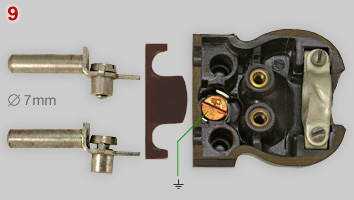 |
| 7 - 9 |
Earthed
25A - 250V plug. The plug
was not polarized, despite a single
side strip for earth contact. It is likely that the matching socket had
two, opposite earth contacts. Manufacturer Voigt &
Haeffner in Frankfurt am Main has its own classification system for
plugs and sockets. The shown model is type 25 II Ste. (25: 25 Amp; II:
2
poles; St: Stecker [=plug, K=socket]; e: Erde [=earth]; also a colour
code could be added: b= brown Bakelite, c= cream/ivory). Dating: mid
1930s. {WN} |
 |
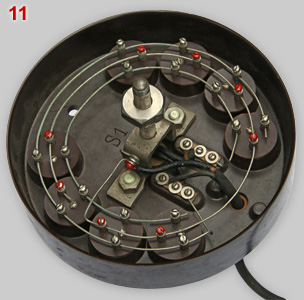 |
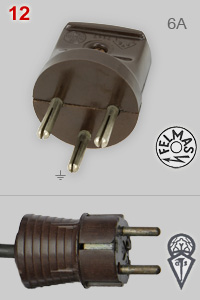 |
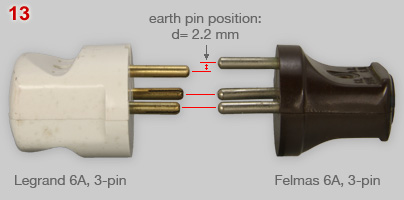 |
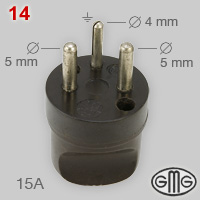 |
|
| 10, 11 |
Top and bottom view of a carousel with eight, earthed 3-pole outlets and a lamp fitting (incomplete). It is not known for which purpose the carousel has been used, but probably it was mounted on a large table where eight people could work with electrical equipment without the inconvenience and danger of eight flex cords to wall sockets. The flex cord of the carousel itself cold have been plugged into a ceiling socket. See image no. 12 for matching type of plug (top) and plug connected to the flex cord (bottom). No name or logo of manufacturer; no certification marks. Dating: probably mid 1930s. {WN} |
| 12 | Top:
three
pin, 6A - 250V Bakelite plug. Trademark: Felmas (Gustav Schortmann,
Leipzig). The carousel was donated to the museum with six Felmas plugs
and two similar plug made by Gebrüder Merten in Gummersbach (GMG).
Pins have a diameter of 4 mm. Bakelite casts of Felmas plugs have been
made by Bisterfeld und Stolting in Radevormwald (Westfalen). Bottom: Schuko plug mounted at the flex cord of carousel no. 10/11. Plug has a Busch-Jaeger logo that has been used form 1926 until 1933. {WN} |
| 13 | The Felmas
6A, earthed plug (see no. 12) and similar GMG plugs resemble a French
6A plug*, made by Legrand in Limoges, but a close comparison shows a
2.2 mm difference in earth pin location. French plugs do not fit in
outlets of carousel no. 10. * See page on classic French plugs and sockets for details. |
| 14 | Because of reparations to the Soviet Union, large parts of Gustav Schortmann (Felmas) equipment was conficated and after 1946 production of installation materials was nearly over. Gebrüder Merten in Gummersbach has continued production of 3-pin earthed plugs for some time and introduced an upgraded 15A model. It has the same pin configuration as no. 12, but L and N pins have a diameter of 5, rather than 4 mm and those pins are not partly split anymore. Dating: probably 1950s. {WN} |
 |
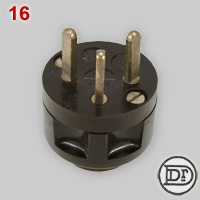 |
 |
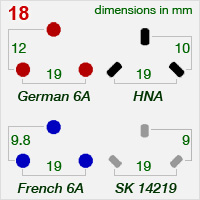 |
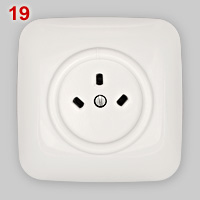 |
 |
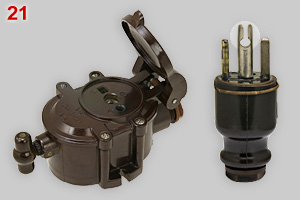 |
| 15 | Earthed 15A - 250V plug, made by Busch & Jaeger. The Terko series for special applications was introduced in the mid 1950s and is still available. Details are given elsewhere. The Busch-Jaeger logo has been used from 1951 until 1979. {WN} |
| 16 | Earthed
10A - 250V plug, made by Dr. Deisting, Spezialfabrik
elektrotechnischer Installations-Apparate und Isolierstoff-Presswerk in
Kierspe (Westfalen). Pin
configuration is identical to still available Merten HNA series*.
Dating of shown plug: late early 1950s.
{WN} * HNA stands for Handelsschiff-Normen-Ausschuss (cargo vessel standard committee). This German shipbuilding standard dates back to the 1920s and later became a part of the Deutsches Institut für Normung (DIN). |
| 17 | 6A - 260V adapter for plugs with no. 16 pin configuration pins to 'standard' 2-pin (4.0 mm / 19 mm). Because the adapter is not earthed, the earth pin slot is a hole only, without contact. No name of manufacturer. Dating; possibly late 1930s. {WN} |
| 18 | Sketches of four 3-pin configurations
shown on this page. Two by two lokalikes, but none is compatible with
another. Red: nos. 10-12 (Felmas); blue: no. 13 (Legrand); black: no. 16 (Deisting, HNA); grey: no. 19 (Stotz-Kontakt 14219). |
| 19 - 20 |
Socket
rated at 10A - 220/380V, made by Stotz-Kontakt. A
matching type of plug is mentioned as order no. 14219 in a 1939-'40
Stotz-Kontakt catalog (see separate page). The Czech company Elektro-Praga (now part of ABB group) has a series of special sockets and plugs, according to Czech standard ČSN 35 4517 (In Czechoslovakian times ČSN ESC 153). Type C1, rated at 10A - 110V AC, is exactly identical to the Stotz-Kontakt socket (see image no. 19). Find the full range of ČSN 35 4517 material on the Czech page. Logos on image no 20 are from left to right: Stotz-Kontakt (socket) + Busch-Jaeger (socket wall plate) and ABB Electro-Praga. Both Stotz-Kontakt and Busch-Jaeger were parts of Brown, Boveri & Cie (BBC). In 1988 BBC and Asea merged and companies of both partners now belong to the ABB Group. Find more information on manufacturer pages (links on general info page). Although the SK socket resembles Australasian 10A sockets, they are incompatible. Spacing and degree of pin rotation of Australasian plugs is substantially different. |
| 21 | Socket and locking plug made by Maehler & Kaege. More images and details are given on a separate page. |
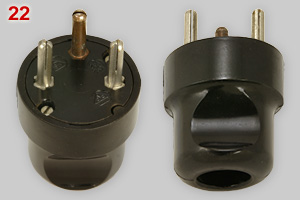 |
 |
 |
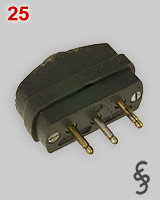 |
 |
 |
 |
| 22 - 24 | Earthed plug, rated at 25A - 250V,
designed by the German company Stotz-Kontakt. The plug is listed in a
1939-'40 Stotz-Kontakt catalog; see catalog page. Plug size: diameter = 49 mm, height = 52 mm. Cable entry allows the use of round cables with a maximum diameter of 21 mm. Although the plug is polarized, L and N pin are not specified. Image no. 24 shows the shape of power pins. Matching 25A sockets had contact holes with corresponding guides that prevent the insertion of less than 25A plugs with round pins. {CW} |
| 25 - 28 | Three-phase
plug and socket rated at 6A - 250V. Because it has no neutral
connection, it was designed for balanced loads, as 3-phase
electro-motors. The pin and wire contacts (see image no. 27) have
clamps to hold fuses for each of the three phases. A fuse, taken from
another socket, is shown in image no. 28. Another interesting feature
that can be seen in the image is the clip in and around the contact
tube to improve pin fixation (see green arrows). Pin sizes: 4.0 mm diameter and length: 18 mm; pin spacing: 30 mm between outer pins; center pin offset: 3.0 mm. Materials used: socket: black and white (inner part) glazed steatite; plug: early synthetic pressed material (not Bakelite), probably reinforced with bitumen, resulting in a reasonably shock absorbing cast. |
| Plug and matching socket have been made by different companies; respectively Siemens-Schuckertwerke in Berlin and Voigt & Haeffner in Frankfurt. V&H, and some other companies were licensed by Siemens. The successful model, meant for commercial use, has been in production from about 1910 to early 1930. A 1930 Siemens catalog mentions explicitly that it is not allowed to use the device for earthed, single phase applications. In the early days of electrification earthed plugs and sockets for domestic use were scarce. The three-phase model could be wired as earthed single phase by connecting the center contact to earth (if available) or neutral. The center fuse had to be replaced by a metal strip. From 1924 it was compulsory that an earth pin makes contact first, which is not the case for the 1910s Siemens model. The Schuko plug, that complied to all regulations, was patented by Siemens in 1930; see 'Origin of Schuko' for details. Find classic three-phase plugs and sockets with neutral and earth contacts at the page on German heavy duty material. |
| |
D i g i t a l M u s e u m o f | |
P l u g s a n d S o c k e t s | |